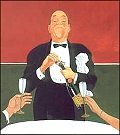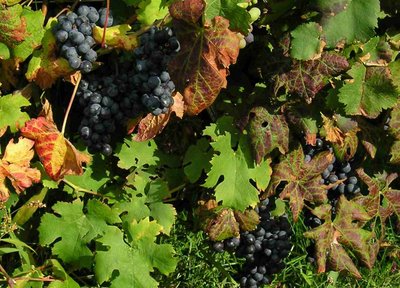Tis The Season For Syrah
For years, our little tasting group got together semi-frequently to indulge in and analyze particular varietals or the wines of a region or country. But then I started working on my master's, and there never seemed to be enough time -- until now. I'm happy to report our group got together again recently for the first time in two years. And, did we ever have a great time comparing wines made primarily from the syrah grape!
We've taste-tested a lot of varietals over the years, but it occurred to me we've never really explored syrah-based wines before -- we came close three years ago when we did a tasting of numerous Rhone wines. It also occurred to me that syrah is a wine I turn to often this time of year when we're having stews and lamb dishes.
So, for this tasting we decided to compare syrah-based wines from California, Australia and France. As is often the case with our little group, there was a clear cut favorite for the majority of our tasters. And, it was a last-minute addition that, surprisingly, blew me away.

We always have a warm-up wine to get things started, and on this night we got things rolling with a 2005 Gigondas La Cave Rose. Though syrah is not the dominant grape in this wine, it was a special way to kick off the evening because it was carried back from France recently by our friends Tony and Kristen. It's not something we can typically get around here -- a real treat. It had perhaps the prettiest bright red/pink color I've ever seen in a rose and intense cherry/strawberry flavors that finished dry and spicy. Very, very tasty.
California
The real tasting began with California, and we were fortunate to have a couple of gems also not typically found around here. We started with a 2004 Lost Canyon Russian River Trenton Station Syrah. This wine comes from a small, high-quality producer (only about 200 cases of this wine were made), but I was nonetheless ready and waiting for a California fruit bomb. Instead, we got a mouthful of black pepper with rich blackberry fruit following close behind. This was a very interesting and enjoyable wine showing real meatiness.
The next wine was a 2002 Tablas Creek Syrah from Paso Robles. Again, nothing simplistic here. The Tablas Creek was a rich mouthful of wine with lots of black cherry, licorice and just a bit of pepper with a pleasant acidic finish. Despite 14.5 percent alcohol, we all agreed the wine was well integrated, balanced.
Australia
Everyone's familiar with the ultra ripe flavors of inexpensive shiraz, so for our tasting I was after a more distinctive taste of Australia. We found that in our first Australian, a 2000 Penfold's St. Henri Shiraz. This was my first taste of this premium label from Penfold's, and it did not disappoint. Less than half as expensive as Penfold's better known monster premium, Grange, St. Henri is supposed to be a more restrained and elegant version.
It is indeed more restrained and, in my opinion, still quite tight. I found it quite Bordeaux-like, with bitter chocolate and mocha notes. This wine needs a few years to really soften and show its stuff. I'm not sure it has the body its big brother boasts, but it's a very serious food wine.
The next Aussie wine, a 2002 Brothers in Arms Shiraz, was the near favorite of many. It's an interesting wine in that it expresses the commitment of a growing number of Australian artisan winemakers who are striving to produce shiraz that exhibits lots of terroir. Hailing from South Australia's Langhorne Creek, this wine shows beautiful, complex flavors of blackberries, smoked meat, rosemary and pepper. Its rich, slightly sweet fruit flavors stay in balance, making it perhaps the best sipping wine (without food) of the bunch.
France
Where to begin, regarding the next wine. The 2001 Mas Cal Demoura L'Infidele from Coteaux du Languedoc blew my socks off -- I certainly never expected anything quite so dramatically good from the Languedoc. It was the clear favorite of 5 out of our 8 tasters -- all the men and one woman. Those who didn't vote it best had to admit it was a lot of wine, just not the style they prefer. You see, it was a virtual explosion of barnyard aromas, from freshly tilled earth to soggy, ripe cow pasture.
OK, I know some people might regard this kind of barnyard experience to be more stinky than pleasurable -- a flaw. But there's no denying it's a big wine for under $30. And, the barnyard quality will fade after an hour or two. Then you can look forward to mushrooms, earth, leather, lead pencil and anise. How many wines can say that?
For our last wine, we again tasted a 1996 Paul Jaboulet La Chapelle Hermitage. We tasted this wine together three years ago, and it was my favorite of the evening. The most expensive wine in our lineup, it's still got some good stuffing, but I did not find it as intense as I remembered it. It has very nice earthy, mushroomy flavors with just a bit of pepper on the finish. Really, it was quite nice, especially after 20 minutes in the glass, but I think it suffered from following the L'Infidele.
Based on some reviews I've read I gather I'm not supposed to like this wine. But I have no trouble recommending it to others -- it's still a class act. But I'm not sure if I can recommend buying any of the current vintages at about $120 a bottle, when there are wines like L'Infidele available for a whole lot less.
Our conclusions: syrah does, indeed, make great world class wines that belong on your dinner table. But you don't have to spend a fortune for great ones, unlike cabernet. The two best loved wines of the evening were the two cheapest at about $28 a bottle. Very cool.
We've taste-tested a lot of varietals over the years, but it occurred to me we've never really explored syrah-based wines before -- we came close three years ago when we did a tasting of numerous Rhone wines. It also occurred to me that syrah is a wine I turn to often this time of year when we're having stews and lamb dishes.
So, for this tasting we decided to compare syrah-based wines from California, Australia and France. As is often the case with our little group, there was a clear cut favorite for the majority of our tasters. And, it was a last-minute addition that, surprisingly, blew me away.

We always have a warm-up wine to get things started, and on this night we got things rolling with a 2005 Gigondas La Cave Rose. Though syrah is not the dominant grape in this wine, it was a special way to kick off the evening because it was carried back from France recently by our friends Tony and Kristen. It's not something we can typically get around here -- a real treat. It had perhaps the prettiest bright red/pink color I've ever seen in a rose and intense cherry/strawberry flavors that finished dry and spicy. Very, very tasty.
California
The real tasting began with California, and we were fortunate to have a couple of gems also not typically found around here. We started with a 2004 Lost Canyon Russian River Trenton Station Syrah. This wine comes from a small, high-quality producer (only about 200 cases of this wine were made), but I was nonetheless ready and waiting for a California fruit bomb. Instead, we got a mouthful of black pepper with rich blackberry fruit following close behind. This was a very interesting and enjoyable wine showing real meatiness.
The next wine was a 2002 Tablas Creek Syrah from Paso Robles. Again, nothing simplistic here. The Tablas Creek was a rich mouthful of wine with lots of black cherry, licorice and just a bit of pepper with a pleasant acidic finish. Despite 14.5 percent alcohol, we all agreed the wine was well integrated, balanced.
Australia
Everyone's familiar with the ultra ripe flavors of inexpensive shiraz, so for our tasting I was after a more distinctive taste of Australia. We found that in our first Australian, a 2000 Penfold's St. Henri Shiraz. This was my first taste of this premium label from Penfold's, and it did not disappoint. Less than half as expensive as Penfold's better known monster premium, Grange, St. Henri is supposed to be a more restrained and elegant version.
It is indeed more restrained and, in my opinion, still quite tight. I found it quite Bordeaux-like, with bitter chocolate and mocha notes. This wine needs a few years to really soften and show its stuff. I'm not sure it has the body its big brother boasts, but it's a very serious food wine.
The next Aussie wine, a 2002 Brothers in Arms Shiraz, was the near favorite of many. It's an interesting wine in that it expresses the commitment of a growing number of Australian artisan winemakers who are striving to produce shiraz that exhibits lots of terroir. Hailing from South Australia's Langhorne Creek, this wine shows beautiful, complex flavors of blackberries, smoked meat, rosemary and pepper. Its rich, slightly sweet fruit flavors stay in balance, making it perhaps the best sipping wine (without food) of the bunch.
France
Where to begin, regarding the next wine. The 2001 Mas Cal Demoura L'Infidele from Coteaux du Languedoc blew my socks off -- I certainly never expected anything quite so dramatically good from the Languedoc. It was the clear favorite of 5 out of our 8 tasters -- all the men and one woman. Those who didn't vote it best had to admit it was a lot of wine, just not the style they prefer. You see, it was a virtual explosion of barnyard aromas, from freshly tilled earth to soggy, ripe cow pasture.
OK, I know some people might regard this kind of barnyard experience to be more stinky than pleasurable -- a flaw. But there's no denying it's a big wine for under $30. And, the barnyard quality will fade after an hour or two. Then you can look forward to mushrooms, earth, leather, lead pencil and anise. How many wines can say that?
For our last wine, we again tasted a 1996 Paul Jaboulet La Chapelle Hermitage. We tasted this wine together three years ago, and it was my favorite of the evening. The most expensive wine in our lineup, it's still got some good stuffing, but I did not find it as intense as I remembered it. It has very nice earthy, mushroomy flavors with just a bit of pepper on the finish. Really, it was quite nice, especially after 20 minutes in the glass, but I think it suffered from following the L'Infidele.
Based on some reviews I've read I gather I'm not supposed to like this wine. But I have no trouble recommending it to others -- it's still a class act. But I'm not sure if I can recommend buying any of the current vintages at about $120 a bottle, when there are wines like L'Infidele available for a whole lot less.
Our conclusions: syrah does, indeed, make great world class wines that belong on your dinner table. But you don't have to spend a fortune for great ones, unlike cabernet. The two best loved wines of the evening were the two cheapest at about $28 a bottle. Very cool.






